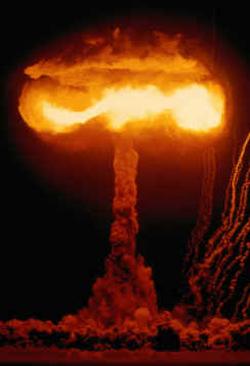Lasers Split the Atom

Two research teams have used the most powerful lasers on Earth to create the first laser-induced nuclear reactions, including the fission of uranium. The results, reported in the 31 January PRL, were predicted by theorists ten years ago but were not possible with the most powerful lasers at the time. The experiments demonstrate that lasers can now be used to study nuclear physics and astrophysical plasmas without going to a major accelerator facility. They may also lead to new information on the behavior of plasmas in a fusion reactor–a power plant that creates energy the same way the sun does.
“With these classes of lasers we’re actually doing nuclear physics,” says Thomas Cowan, leader of the University of California team at the Lawrence Livermore National Laboratory, one of the groups to accomplish the feat. “You’re able to do with lasers what you primarily only do with accelerators.” Across the Atlantic, researchers achieved similar results at the Rutherford Appleton Laboratory in Oxfordshire, United Kingdom.
Before each high-power laser shot, the Livermore team hit their solid gold target, mounted on a copper sample holder containing uranium, with a lower-energy pulse to briefly create a plasma of electrons at the target’s surface. They then used the world’s first petawatt (1015 W) laser to blast the gold with a 0.5 ps,260 J pulse of infrared light–packing more than 1020 W/cm2–which accelerated plasma electrons to energies of tens of MeV. The “quivering” of these electrons created gamma rays known as Bremsstrahlung radiation that liberated high-energy neutrons from gold and copper nuclei. These neutrons split uranium-238 nuclei and caused other nuclear reactions. With two strategically placed detectors, Cowan and his colleagues monitored the energies of electrons escaping the plasma during the laser pulse.
Later analysis of the target revealed the presence of radioactive isotopes of gold, copper, and other elements, all products of nuclear reactions initiated by the high-energy neutrons. The Livermore team found that the quantities of isotopes created agreed with calculations based on the electron energy distributions they measured. Cowan says the main difference between his group’s work and that of the British team was his group’s ability to measure the electron energies.
The Appleton Lab researchers used a laser nearly as powerful, the 50 terawatt (50 x 1012 W) VULCAN laser, which delivered 50 J of light in a 1 ps pulse, but the primary target for their beam was tantalum, rather than gold. By placing different materials behind the tantalum slab, the British team generated nuclear reactions in potassium, zinc, and silver, and the fission of uranium.
According to John Dawson of the University of California at Los Angeles, these results initiate a new class of nuclear physics experiments. He says the techniques could be used to study the interactions of gamma ray photons with one another as well as the physics of electron-positron plasmas–which can model the so-called gamma ray bursters in the cosmos. Most importantly, says Dawson, these findings may expand opportunities for the field of nuclear physics: If such lasers can be reduced in size and complexity, researchers may some day perform desktop physics experiments in areas previously ignored because there wasn’t enough beam time on the multi-million-dollar particle accelerators.
–Andrew Gannon
Andrew Gannon is a freelance science writer.


